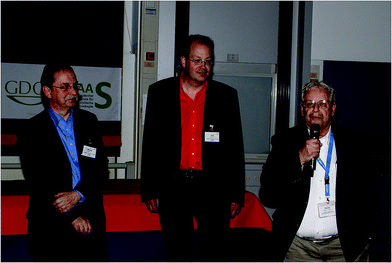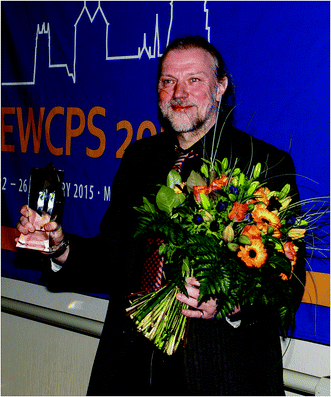2015 European Winter Conference on Plasma Spectrochemistry
Uwe
Karst
a and
Michael
Sperling
b
aChair of the 2015 EWCPS, University of Münster, Germany. E-mail: UK@uni-muenster.de
bCo-Chair of the 2015 EWCPS, University of Münster, Germany and European Virtual Institute for Speciation Analysis, Germany. E-mail: Michael.Sperling@uni-münster.de
![[thin space (1/6-em)]](https://www.rsc.org/images/entities/char_2009.gif) 000 students, the third largest university in Germany. The buildings of the Chemistry and Physics departments provided the lecture halls for up to four parallel sessions, additional rooms for board meetings and vendor seminars, and an exhibition hall to host part of the exhibition. This conference continues the successful tradition that was started 30 years ago with the first European version of the Winter Conference on Plasma Spectrochemistry in Leysin, Switzerland, and has since been held in Germany three times, interestingly with a constant period of 12 years inbetween events. This meeting gathered more than 720 participants from 45 countries, the most represented being scientists from Germany (278), the USA (60), the United Kingdom (40), Spain (39), Austria (32) and France (22). A significant number of Asian and African participants included, among others, plasma spectroscopists from Japan (22), Korea (14) and China (8). The overwhelming response of participants to the call for papers and the quality of submitted presentations motivated the organizers to change the traditional conference format to a full four-stream program. This way, 6 short courses, 178 oral presentations and more than 260 posters made up a dense scientific program lasting from Sunday afternoon to Thursday afternoon. The overall program was organized with the aim to stimulate fruitful discussions between students, professors, instrument manufacturers, corporate and government scientists from different application fields.
000 students, the third largest university in Germany. The buildings of the Chemistry and Physics departments provided the lecture halls for up to four parallel sessions, additional rooms for board meetings and vendor seminars, and an exhibition hall to host part of the exhibition. This conference continues the successful tradition that was started 30 years ago with the first European version of the Winter Conference on Plasma Spectrochemistry in Leysin, Switzerland, and has since been held in Germany three times, interestingly with a constant period of 12 years inbetween events. This meeting gathered more than 720 participants from 45 countries, the most represented being scientists from Germany (278), the USA (60), the United Kingdom (40), Spain (39), Austria (32) and France (22). A significant number of Asian and African participants included, among others, plasma spectroscopists from Japan (22), Korea (14) and China (8). The overwhelming response of participants to the call for papers and the quality of submitted presentations motivated the organizers to change the traditional conference format to a full four-stream program. This way, 6 short courses, 178 oral presentations and more than 260 posters made up a dense scientific program lasting from Sunday afternoon to Thursday afternoon. The overall program was organized with the aim to stimulate fruitful discussions between students, professors, instrument manufacturers, corporate and government scientists from different application fields.
In order to introduce the younger participants to the different techniques of plasma spectrochemistry, as well as to encourage scientific discussions, 6 short courses free of charge for all participants were included in the program. The two-hour courses were given during the first conference day on Sunday afternoon by highly recognized experts in the field, namely Ramon Barnes (Fundamentals of ICP spectrometry), Gary Hieftje (Glow discharges), Jacob T. Shelley and Carsten Engelhard (Direct analysis with ambient mass spectrometry), Philip Doble (Practical considerations of elemental bio-imaging by LA-ICP-MS), Maria Montes-Bayon (New applications of ICP-MS in bioanalysis) and Frank Vanhaecke (Isotopic analysis using ICP-MS for beginners). All courses were well attended with a total number of over 200 participants.
The scientific program was framed by plenary lectures at the beginning and the end of each day, discussing some major topics related to plasma spectrochemistry. The program started on Sunday late afternoon with two plenary lectures presented by Gary Hieftje (“Advances in and Alternatives to the ICP for Atomic Emission Spectrometry”) and Uwe Karst (“Speciation Analysis and Elemental Bioimaging in Biomedical and Clinical Analysis”) giving a first impression of the broad range of topics to be discussed during this important event. Other topics discussed by plenary speakers were “Recent Progress and Future Prospects in ICP-MS Modeling” by Annemie Bogaerts, “ICP MS in Metallomics – State-of-the-Art and Perspectives” by Joanna Szpunar, “Science and Applications of Measuring Every Element on the Periodic Chart Simultaneously using Laser Ablation with LIBS and ICP-MS” by Richard Russo, “Plasma Mass Spectrometry, a Tool for Genomic Biomarker Analysis in Cancer Studies” by Maria Montes-Bayón, “Trends in Bio-Imaging” by Philip Doble, “ICP-Mass Spectrometry as an Emerging Tool for Medical Diagnosis” by Frank Vanhaecke, and “Running the Mass-Spectral Gamut: Atmospheric-Pressure Plasmas for Biological, Molecular, and Atomic Mass Spectrometry” by Jacob Shelley.
The dense scientific program followed a four streams format including vendor seminars and poster sessions. The program topics for the four sessions were selected in a way to allow participants with different areas of interest to create their individual program with interesting sessions for each day. Sessions were dedicated to speciation analysis, metallomics, nanoparticles, isotopes, laser ablation/LIBS, metrology, environmental analysis, energy and fuels, fundamentals, instrumentation, alternative plasmas and glow discharges. Each stream was initiated by a keynote lecture.
The sessions were interrupted with coffee and lunch breaks, vendor seminars and poster sessions with about 90 posters each that discussed topics covered by the lecture sessions. The four streams were nicely synchronized and coffee breaks gave the opportunity to meet with colleagues, exhibitors and to discuss posters, future projects or simply enjoy the nice weather that encouraged participants to change between the two buildings of the conference or to walk the short way to the mensa for the lunch break. Since coffee and refreshments were offered throughout the day, any individual break could be used to visit the exhibition or the posters or to meet with others.
On Tuesday afternoon, the European award for plasma spectrochemistry was announced. This award—sponsored by Agilent Technologies and awarded by the independent scientific panel—was attributed to Jörg Feldmann (University of Aberdeen, UK) (Fig. 1). Jörg Feldmann’s award winning research was on arsenolipids with respect to occurrence in marine organisms, their distribution and toxicity.
An important part of contributed presentations were presented in poster sessions during the afternoons. More than 260 posters were presented during three poster sessions close to the exhibition and lecture halls. Of each poster session, the best three posters were selected by an international poster jury for a poster award. The winners of the Monday poster session were Monika Winkler from the TU Graz, Talke Marschall from the University of Potsdam and Bastian Franze from the University of Münster. The winners of the Tuesday poster session were Andreas Zitek from the University of Natural Resources and Life Sciences, BOKU Vienna, Marcia F. Mesko from the Federal University of Pelotas, and Silvia Queipo from the University of Oviedo. The winners of the Wednesday poster session were Tim Elseberg from the University of Münster, Christine Opper from the University of Natural Resources and Life Sciences, BOKU Vienna and Karen Murphy from the National Institute of Standards and Technology (NIST).
The exhibition of instrument and equipment manufacturers and publishers of scientific literature was an integral part of the conference. The exhibition also was the common meeting point for all participants joining together from the different sessions. Special thanks go to all sponsors for their support. The great number of sponsors (14 out of the 29 exhibitors acted additionally as sponsors) and their generous sponsorship supported the whole conference and enabled the organizers to charge low conference fees especially for young scientists.
The broad scientific program was be counterbalanced by a stimulating social program. The social program was very generously supported by sponsors allowing for ample participation of students and young scientists. It started already on Sunday evening with a Welcome Reception in the Exhibition halls. The organizers deviated from the traditional schedule and invited the participants already during on first evening to join for the conference dinner at a very special place, Münster's zoo. The whole zoo was open to the participants throughout the evening and guided tours highlighted certain sections of the zoo with a bar in the elephant house where cocktails were served. A buffet was waiting in the zoo restaurant and different bars where serving drinks, so that all participants had ample time to enjoy the dinner, the attractions of the zoo and short walks to meet with many participants during the evening. More than half of the participants joined for this special event, and those who did will certainly remember it as a very special experience. On Tuesday, participants were invited for a guided city tour. The evening continued with dinner invitations by several exhibitors in different locations in the city. Participants could select between typical places in Münster such as the LWL Museum (Agilent), the brewery “Pinkus Müller” (Shimadzu), the open air museum Mühlenhof (Thermo) or the traditional restaurant “Grosser Kiepenkerl” (Meinhard/ESI). One of the most traditional events of this conference is the Hot Plasma party, which took the conferees on Wednesday evening to the restaurant “Uferlos” at lake Aasee, for dinner and dancing until the early morning. Finally, the conference ended with a farewell reception that offered the possibility to say goodbye to old and new friends and to start the journey back home after some refreshments.
At the closing ceremony and the following farewell reception (Fig. 2), everybody was convinced that this event was a real success in bringing people together for fruitful discussions that resulted in new ideas for future projects and cooperation. The next EWCPS will be organized by Thomas Prohaska and his team in the ski resort St. Anton in Austria in 2017, and will be an excellent opportunity to meet again for discussing new achievements.
 | ||
| Fig. 2 Co-chair Michael Sperling, Chair Uwe Karst and Joe Caruso (from left to right) at the closing ceremony. | ||
The current issue of JAAS provides a selection of the work presented at the conference. While this collection can of course only give a glimpse into the broad range of topics discussed, we hope that it may serve as proof of the scientific quality of the work presented during the European Winter Conference on Plasma Spectrochemistry 2015 in Münster.
| This journal is © The Royal Society of Chemistry 2015 |

